
With the large selection of construction lasers available these days, it can be a tough job just shopping and deciding on a model to purchase. The task of researching the various models is more than most people want to deal with or have the time to spend.
We will attempt to explain which features do what and which product best fits your needs. Basically speaking, the first thing you should do is figure out what jobs you plan to accomplish with your laser. Do you intend to work only indoors, only outdoors, or both? Do you want to install pipe underground, chair rails in a dining room, fence posts, and construction site grading? These are the questions that will define the features you will want to look for and buy.
What are construction lasers used for you ask?
They are used in a variety of jobs where layout is performed and an accurate, level reference is needed. Jobs such as, installing ceiling tiles, installing chair railings in a dining room, installing receptacles for power within a home under construction. Some tasks are small, such as hanging pictures in a level fashion across a living room wall. Some tasks are large, such as installing sewer pipe or handling a site grading plan for a new building.
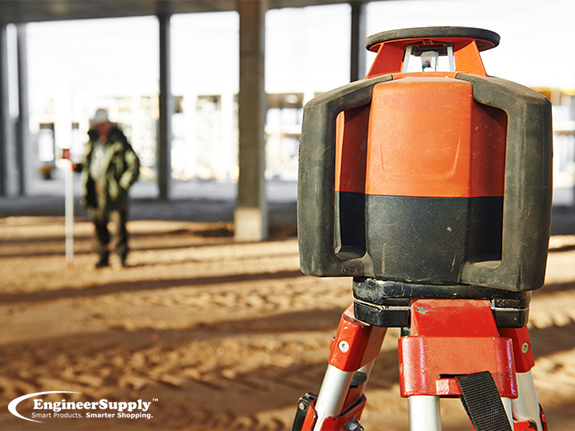
Indoor Applications of Laser Levels
- Align and plumb your walls
- Leveling floors
- Attach your laser to a wall or ceiling mount for easy drop ceiling installation
- Easily check door or window heights
- Installing drop ceilings
- Install chair rails and wainscoting in your home
- Align shelves, cabinets and trim
- Use a tripod for easy installation and alignment of cabinets, chair rails, etc
Outdoor Applications of Laser Levels
- Any type of basic surveys
- Lasers easily check and level posts and beams on decks, fences and porches
- Masonry alignment
- Site layout
- Easily check land elevations
- Lasers with a slope capability can set grade for proper drainage and irrigation
- Align fences, posts and decks
- Establishing grades
- Contour farming or drainage
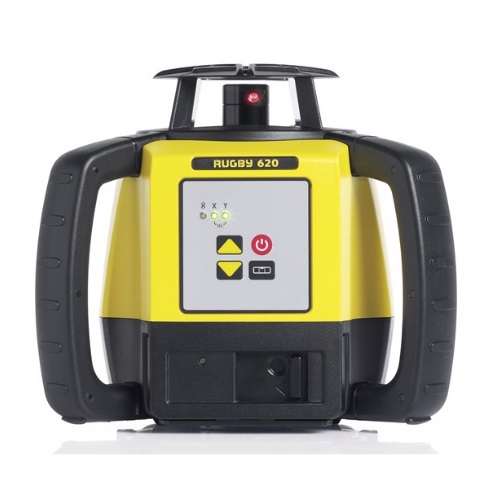
Great Selection of Construction Levels
Shop from top brand names today! Whether you're looking for Rotary laser levels, Line laser levels, Pipe Lasers or other laser leveling equipment we have you covered.
SHOP CONSTRUCTION LASERS
When selecting a construction laser, it's not only application-specific, there are basically three types of lasers to make your layout less time consuming for certain distances in construction. They are PLUMB ("Dot LASERS"), LINE LEVEL ("Line Generators"), or ROTARY. For distances from 1' to 150', we recommend PLUMB or LINE GENERATORS. For 200' or greater, we recommend ROTARY. These are basic rules of thumb on model selection and things can always vary depending on your exact task or application.
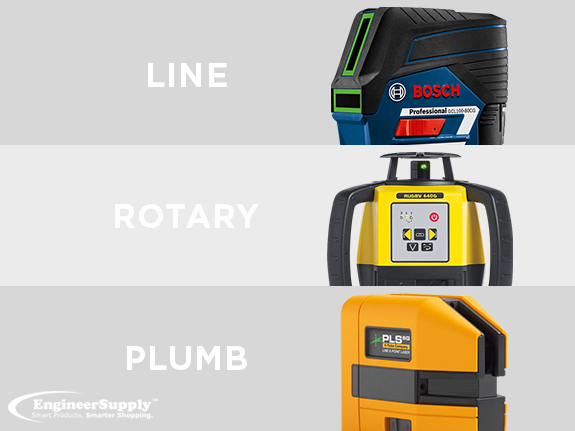
First, let's discuss the basic models. The following levels emit their lasers in various ways
Plumb or Dot Lasers
These lasers produce single or multiple dots of reference on the wall or work surface. They work much like a reference point, or a laser plumb bob.
Line Level Lasers (Also known as Laser Line Generators)
Another type is one that emits a level line on the wall in a single line or a cross-hair type of fashion. Typically, these types only emit level lines in one direction and onto a single wall or workspace. These are typically used indoors, and are usually small hand-held types of lasers either positioned on a ladder, sawhorse, desk, etc, or mounted to a light-weight jamb-pole or laser platform that extends from floor to ceiling.
Rotary Level Lasers
Then, the other type is a rotary laser, which emits a level line in a rotary fashion. Rotary lasers typically emit a level line around the entire room in 360 degrees. Rotary Lasers are usually a little larger and are mounted on sturdy surveying tripods. Some Rotary Laser Levels can be laid over on their side, using an optional trivet that allows them to project on a vertical plane when used in this manner. The rotation of a single laser makes the human eye think it is seeing a line around the room. Hence the name, Rotary Laser. Most Rotary Lasers work well inside, but if you want to work outside, you'll need to make sure you have a laser detector, also known as a laser receiver. This is because the human eye cannot see the laser outside in daylight no more than several feet. More is mentioned below in this article about Laser Detectors.
With the above explanation of how the lasers emit their lines or points, now lets dive into varying types or features of laser levels
Manual-Leveling Lasers
A manual leveling laser requires the operator to manually level the unit by turning the units thumbs screws and getting the unit leveled by looking at the bubble vials.
Self-Leveling and Automatic-Leveling Lasers
A self-leveling laser automatically finds and maintains a level within a specified range. Some lasers have a bubble vial and you perform rough leveling and then the laser itself will take over and do the fine leveling. Or, some you get the laser set up and somewhat close to being level, and then the laser will level itself. And, many self or auto-leveling laser levels will continue to level itself if the setup or platform becomes jarred accidentally. And, many times they will shut themselves off if they get out of level by say 3% or 5% in an attempt to stop you from using the beam as a reference. Also, you should note that some lasers advertise themselves to be Automatic-Leveling. Please be aware that the terms self-leveling and automatic-leveling can mean different things. The terms "self leveling" and "automatic leveling" tend to conflict one another if you're new to laser terminology. Most Self-Leveling Lasers have an internal Pendulum that does the leveling. And some that are called Automatic-Leveling Lasers have electronic servo motors that do all of the leveling for you. We recommend taking the time to read, ask, and learn the differences once you have narrowed down a few lasers when making your decision.
Horizontal Lasers
A horizontal beam laser will only emit a single beam from its beacon.
Dual-Beam Lasers: (also known as Split-Beam Lasers)
These types of laser levels emit horizontal or vertical beams to establish both level and plumb reference lines. Please note that the term of Dual-Beam really just means that the laser is able to produce its regular plane and produce a reference point such as a plumb-up dot on the ceiling. Don't assume that the laser you want will produce a horizontal and vertical "plane" at the same time. Usually when a laser is described as "Dual-Beam", it usually means one level beam like with a Rotary Laser producing a flat line around the room, and the other beam is simply a plumb-up "dot" on the ceiling. We are unaware of any Rotary Laser that will produce both horizontal and vertical level loops around the room at the same time. Most Rotary Lasers are either horizontal or vertical, (one or the other, not both). Dual-Beam is just another beam, not necessarily another "plane", as the second beam could be a simple "dot" reference point.
Laser Detectors (Laser Receivers)
Also, an integral part of using a Rotary Level Laser is a laser detector. Laser detectors are also known as laser receivers. Laser Detectors typically mount to level rods and work to detect the laser beam when you're working outside. Most always, a laser detector is required if you're working outside with a laser level since a laser line is difficult to see during the daytime hours. Most detectors produce sound, a short beep when you're close to being on level, and then a steady, solid beep tone when you're at level. Laser Detectors can shorten the amount of time needed when trying to find the level beam and get on level. Most Detectors have a visual and audible alarm. The visual is usually an LCD screen and the audible is a beeping noise that beeps faster and faster the closer you get to being on level. When you do get on level, a solid tone that alerts when you're on level. Most detectors will give you a fast tone if you need to move the detector down, a slower tone if you need to move up, and a steady tone when you are on grade.
Fixed versus Variable Rotation Speeds of Rotary Lasers
Rotary Lasers come with either a Fixed Rotation Speed or a Variable Rotation Speed. RPM (Rotations Per Minute) represents the number of times the laser in a Rotary Laser rotates in one minute. Most Construction Rotary Lasers have either a fixed RPM or a variable RPM. A faster RPM is dimmer but travels farther (so you get more range). A slower RPM does not travel as far but is brighter and easier to see. Use a slower RPM when inside because the beam will be easier to see and a faster RPM when outside because it will travel farther.
When doing exterior work (outside jobs such as grading, setting culverts, concrete driveways) you need one speed, and that speed is fast. The line from a rotary laser is not visible to the human eye outdoors in bright sunlight, so you will need to use a laser detector to find the exact location of the laser line. The faster the rotation, the harder it is for a human eye to see it, but the laser detectors work better with faster rotations. For a Rotary Laser Detector (Also known as a "Receiver") to locate the line the RPM must be at least 600.
Rotary Laser Levels with variable speeds work well for interior work. A variable RPM allows the user to adjust the laser to the speed of best visibility. Slower rotations have a more visible beam. Faster rotations resemble a chalk line. You’ll want to set the rotation slow enough to where it is just fast enough to be considered a solid line on the wall, as this allows for the best mix of solid and brightness. If you need a solid dot reference set the laser at 0 RPM.

Summary
The laser levels we just discussed are available with varying features. These features may include variable rotation speeds, beam scanning, grade capability, remote controls, rechargeable battery packs, AC chargers and more. Attachments may include a wall/ceiling mount laser platforms, detectors, and trivets for mounting a laser on its side to a tripod for interior work. We recommend you take the time to decide on which jobs or tasks you plan to accomplish while using a laser level. Possibly take the time to write these down on paper, then start your search. We recommend that you look over the varying comparison charts for David White, CST/Berger and Pacific Laser Systems Laser Levels as they can quickly point out which units have which features.
We recommend you take the time to review the varying types of laser level specifications such as the range the laser will emit and accuracy specifications. Working with a construction laser level can save you time and labor while increasing your accuracy. Many setups allow a person to work alone when using a detector on a leveling rod instead of a two-person job with a regular (non-laser) level.
We hope that our document about Construction Laser Levels has helped you learn a bit about them and how they work. And, hopefully, you are now off to a good start at selecting the right laser level for you.
Copyright 2006-2020 EngineerSupply
More Articles About Lasers
Frequently Asked Questions
What are the best types of laser levels to use in construction?
Because there’s such a large selection of
laser levels, it can be hard to know which one is right for you. Line lasers are the most common, because they project a straight-line reference that works both horizontally and vertically. But you can also choose from any of the following:
- Spot Lasers — Project a small circle of light onto a surface on which the laser is focused. This tool is good for making sure a joist or wall is plumb and that pipes moving from one floor to another are also plumb.
- Combination Lasers — Emit both lines and spots either at the same time or independently, which is a great choice if you work on a variety of projects.
- Rotary Lasers — Can be used on almost every type of construction job, from grade work to layout and masonry.
If you’re looking for a self-leveling laser or any other type of laser leveling tool, be sure to look at what we have at Engineering Supply.
What is the accuracy of a laser level?
Good
laser levels are accurate withing 1/16 of an inch per 100 feet. This is ten times more accurate than a spirit level, which is only 1/2 inch per 100 feet. This level of precision is made possible through a laser diode that emits a concentrated beam across the area you need to level.
How are laser levels used in construction?
There are many ways on how to use a
laser level. Some of them include but may not be limited to:
- Aligning and plumbing walls.
- Leveling floors.
- Drop ceiling installations.
- Checking door or window heights.
- Installing chair rails and wainscoting.
- Aligning shelves, cabinets, and trims.
- Basic surveying.
- Leveling posts and beams on fences, decks, and porches.
- Masonry alignments.
- Site layouts.
- Checking land elevations.
- Establishing grades.
For a broad selection of
laser levels and other construction tools, feel free to look at what we have at Engineering Supply.
Where can I buy a quality laser level?
Whether you’re looking for a self-leveling laser or any other laser leveling device, you can find what you need at Engineering Supply. We’re one of the leading suppliers and dealers of high-quality tools used in construction, surveying, architecture, and engineering. Feel free to look at what we have in stock, so you can find a tool that will meet your specific needs.
How do I use a laser level?
Because they can come in a variety of designs, laser levels can work in a number of ways. A manual laser level works in a more “traditional” manner. You line up the laser by positioning the level or turning a knob while looking at a bubble vial that will tell you if the instrument is level. This type of laser level is less expensive and doesn’t need as much battery power. A self-leveling laser is more expensive, but it can give you a much higher degree of accuracy. It works best when the unit is placed on a surface that you have determined to be “close to level,” and you can use a bubble vial to level it manually before you start the self-leveling mechanism.
If you’re looking for a place to find quality laser levels from some of the best manufacturers on the market, be sure to look at what we have in stock.
Best Laser Levels
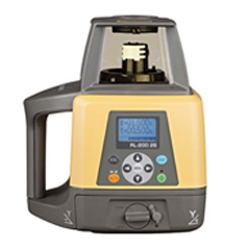 This laser level is perfect for doing exterior work, and it comes with the following accessories:
This laser level is perfect for doing exterior work, and it comes with the following accessories:
- Rechargeable battery kit.
- LS-100D laser detector with the Holder 6 rod clamp.
- RC-400 remote control.
- Hard carrying case.
The unit itself has the following specifications:
- Red laser beam.
- 2 AA batteries as a power supply.
- Low battery indicator.
- IP66 Rating.
If you’re looking for the best
laser level for your specific needs, be sure to pick yours up at Engineer Supply today!
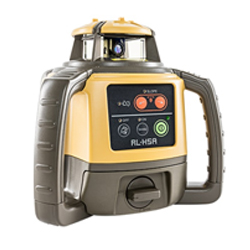 This laser level and receiver has the following features:
This laser level and receiver has the following features:
- Operating range of up 800 meters.
- Smart long-range receiver.
- Rotation speed of 600 RPM.
- Simple and intuitive manual slope capability.
- Horizontal accuracy of up to 10 arc seconds.
- Self-leveling range of up to 5 degrees.
- Up to 100 hours of battery life.
- IP66 Rating for protection against dust, sudden showers, and torrential rainfall.
If you’re looking for the best
laser level for establishing a horizontal line reference with an incredible degree of accuracy, be sure to pick yours up at Engineer Supply today!
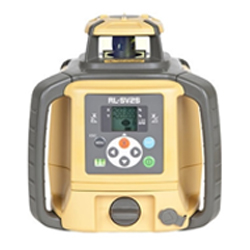 This Topcon laser level package is great for horizontal, multi-slope, and vertical applications. It also includes the following accessories:
This Topcon laser level package is great for horizontal, multi-slope, and vertical applications. It also includes the following accessories:
- Rechargeable battery kit.
- LS-100D laser detector with the Holder 6 rod clamp.
- RC-60 remote control.
- Hard carrying case.
The tool itself has the following specifications:
- Red laser beam.
- Operating range of 800 meters in diameter with a laser detector.
- Accuracy of 1/16 of an inch for every 100 feet.
- 300/600 RPM rotation speed.
- IP66 Rating for protection against dust and heavy jet spray.
If you’re looking for one of the best laser levels for a number of construction applications, be sure pick yours up at Engineer Supply today!
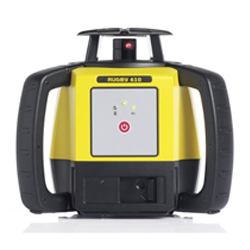 Like many other laser levels in this series, this tool is a professional solution with an excellent balance of quality and price. It will allow you to perform quick leveling and alignments for general construction and interior applications. Its housing is extremely durable, so it can perform according to the highest standard in even the harshest of job conditions. It will also work with all Leica Rod Eye Receivers, which will extend its working range up to 2,000 feet (600 meters).
Like many other laser levels in this series, this tool is a professional solution with an excellent balance of quality and price. It will allow you to perform quick leveling and alignments for general construction and interior applications. Its housing is extremely durable, so it can perform according to the highest standard in even the harshest of job conditions. It will also work with all Leica Rod Eye Receivers, which will extend its working range up to 2,000 feet (600 meters).
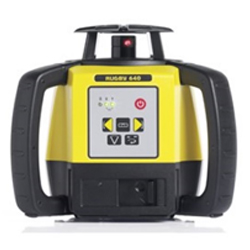 Like many other models within this series, this is the best laser level for someone who needs a professional solution with an excellent price-to-quality ratio. With this tool, you’ll be able to do any kind of construction job that requires quick leveling and aligning while eliminating costly errors, rework, and downtime. Because of its rugged housing that’s both dust and water proof, this laser level is built for the construction site. It will perform according to the highest standards in all kinds of job conditions, which is why this series of laser levels is perfect for any construction professional.
Like many other models within this series, this is the best laser level for someone who needs a professional solution with an excellent price-to-quality ratio. With this tool, you’ll be able to do any kind of construction job that requires quick leveling and aligning while eliminating costly errors, rework, and downtime. Because of its rugged housing that’s both dust and water proof, this laser level is built for the construction site. It will perform according to the highest standards in all kinds of job conditions, which is why this series of laser levels is perfect for any construction professional.
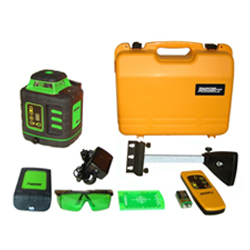 This dual-slope rotary laser level with Greenbrite Technology is the perfect tool for indoor construction projects. It’s a great tool for contractors, finish carpenters, and builders because of the visibility and accuracy it provides. The electronic self-leveling will work on both the horizontal and vertical planes. And because of its green laser beam, it will be 400% more visible than a red-beam laser level (which will make leveling tasks faster and more accurate).
This dual-slope rotary laser level with Greenbrite Technology is the perfect tool for indoor construction projects. It’s a great tool for contractors, finish carpenters, and builders because of the visibility and accuracy it provides. The electronic self-leveling will work on both the horizontal and vertical planes. And because of its green laser beam, it will be 400% more visible than a red-beam laser level (which will make leveling tasks faster and more accurate).
It’s the best laser level for a number of indoor applications, which can include but may not be limited to:
- The layout of interior walls.
- Checking door and window height.
- Installing acoustical and drop ceilings.
- Developing a layout for warehouse racking.
- Room additions.
- Drywall installations.
Be sure to pick yours up at Engineer Supply today!
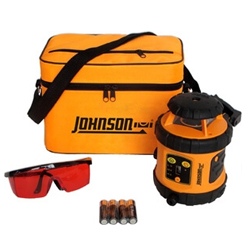 This self-leveling rotary laser level has a locking mechanism that protects the inner pendulum while it’s being transported from one place to another. It also has visual and audible alarms when it goes beyond its leveling range. The unit is powered by four AA batteries, and it comes with tinted glasses as well as a soft-sided carrying case. The laser level also has the following specifications:
This self-leveling rotary laser level has a locking mechanism that protects the inner pendulum while it’s being transported from one place to another. It also has visual and audible alarms when it goes beyond its leveling range. The unit is powered by four AA batteries, and it comes with tinted glasses as well as a soft-sided carrying case. The laser level also has the following specifications:
- Pendulum self-leveling method.
- Red Class IIIa laser beam.
- Accuracy of 1/8 of an inch for every 50 feet.
- Interior range of up to 200 feet in diameter (depending on lighting conditions).
- Exterior range of up to 800 feet in diameter with a detector.
- Self-leveling range of up to 3 degrees.
- Approximately 20 hours of battery life with a rechargeable battery pack.
- Approximately 24 hours of battery life with alkaline batteries.
If you’re looking for one of the best laser levels on the market, be sure to pick yours up at Engineer Supply.
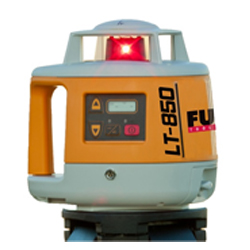 This self-leveling single-slope laser is as rugged, reliable, and accurate as it is affordable. And it’s the best laser level for any kind of level or sloped applications. This tool comes with a number of features, which include:
This self-leveling single-slope laser is as rugged, reliable, and accurate as it is affordable. And it’s the best laser level for any kind of level or sloped applications. This tool comes with a number of features, which include:
- Fully automatic self-leveling.
- Height of Instrument (HI) alert.
- Operating radius of 2,000 feet.
- Machine Control Compatible.
- Accuracy of 10 arc seconds.
It also comes with a standard CR3 Laser Detector, so be sure to pick yours up at Engineer Supply.
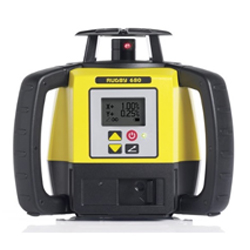 Like all other laser levels in the Rugby Series, this tool is the perfect professional solution for someone who is looking for a good balance of quality and price. Not only will it allow you to perform quick level operations in general construction and interior applications, but it will also help you to eliminate costly errors. Because of its rugged housing, this tool is built for the construction site. It can perform at the highest level in even the worst job conditions. So if you’re looking for the best laser level for your next construction project, be sure to pick yours up at Engineer Supply.
Like all other laser levels in the Rugby Series, this tool is the perfect professional solution for someone who is looking for a good balance of quality and price. Not only will it allow you to perform quick level operations in general construction and interior applications, but it will also help you to eliminate costly errors. Because of its rugged housing, this tool is built for the construction site. It can perform at the highest level in even the worst job conditions. So if you’re looking for the best laser level for your next construction project, be sure to pick yours up at Engineer Supply.
 This laser level has a vertical mount and is great for both indoor and outdoor construction applications. Carpenters, plumbers, and electricians will love using this tool, because it’s as versatile as it is accurate. The self-leveling mechanism will work on both the horizontal and vertical planes. It can also be useful in the following applications:
This laser level has a vertical mount and is great for both indoor and outdoor construction applications. Carpenters, plumbers, and electricians will love using this tool, because it’s as versatile as it is accurate. The self-leveling mechanism will work on both the horizontal and vertical planes. It can also be useful in the following applications:
- Leveling.
- Checking cut and fill.
- Setting foundations and footings.
- Septic tank and basement excavations.
- Acoustical ceiling and drywall installations.
- Aligning and plumbing walls.
- Contour framing.
If you’re looking for the best
laser level for your specific needs, be sure to pick yours up at Engineer Supply.
Please Wait...
